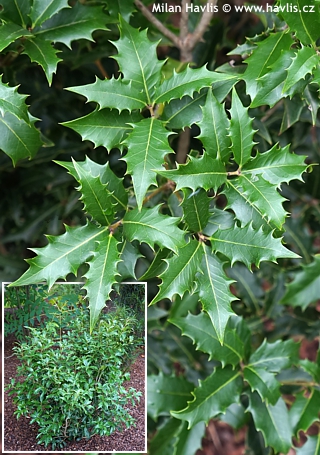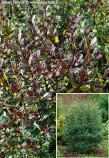Osmanthus heterophyllus 'GULFTIDE'

Osmanthus heterophyllus 'GULFTIDE'
holly osmanthus, false holly
holly osmanthus, false holly
| SIZE/TYPE | medium-sized shrub |
|---|---|
| taller shrub | |
| USUAL HEIGHT | 2-4m |
| USUAL WIDTH | 1.5-2.5m |
| LEAVES | evergreen broadleaf |
| COLOUR OF LEAVES |
 green green |
| FLOWERS | less showy but noticeable |
| BLOOMING TIME | September - October |
| LOCATION | full to partial sun |
| SOIL TYPE | acidic (peaty) to neutral |
| SOIL MOISTURE REQUIREMENTS | evenly moist but well-drained |
| USDA zone (lowest) | 5b (down to -27°C) |
| WINTER PROTECTION | |
| FOR ZONE 5+6 |

|
| FOR ZONE 7 |

|
| BELONGS TO CATEGORIES |
Evergreen broadleaf Hedging plants |
Osmanthus is a genus of only about 15-20 evergreen species and varieties, and a genus which I fell in love with the first time I saw a few plants of. Holly osmanthus or false holly is a taxon of evergreen shrubs and small trees native to East Asia, southern Japan, and Taiwan. It bears evergreen and usually thorny leaves which resemble hollies, but something seems to be wrong for the more experienced eye: holly leaves are alternate while osmanthus leaves are opposite.
Gulftide is an American variety of holly osmanthuswhich originated in Gulf Stream Nursery in Virginia, possibly in 1980’s. It is easily distinguished by heavily serrated / spiny leaves and more uniform, dense growth. Its evergreen leaves are 5-8 cm long, deep green, and glossy. In spring they emerge mahogany red to bronze orange. In autumn the plant produces a profusion of tiny, sweetly scented, snow-white flowers. If pollinated by a male plant they are followed by small, purplish black, non-toxic berries, but that happens rarely.
It naturally forms strictly upright, slow to medium-fast (20-30 cm per year) growing shrubs which can be easily maintained and shaped by pruning. Spring pruning enhances branching, summer trimming is great for shaping. The twigs and bark are light gray and smooth.
Spiny-leaved osmanthus have long been used as a natural barrier against wild animals and cattle. Another important advantage is that they are long-lived shrubs or trees, and we are not talking about decades but hundreds of years. There are records of specimens whose age was estimated to 950 or more years. In other words, if located in an ideal spot it can be a plant that will be passed on by one generation to another. It looks great as an attractive evergreen specimen shrub or small tree, and does a good job as a hedge, too.
Grow osmanthus in moist but well-drained, humus rich, preferably acidic soil. Provide plenty of mulch for winter to protect the roots from fast freezing. It loves full sun but in colder regions find it a location sheltered from late winter and early spring sunlight but with plenty of light during the growing season. Use only plants with mature wood in zone 6 and transplant it no later than late summer in order to avoid frost damage after the first winter. Gulftide is a variety hardier than the species or most other varieties allegedly surviving temperatures of USDA zone 5b, i.e., -27 °C without damage. It does not suffer from diseases, but vine weevil can be a problem. Drought tolerant.
Last update 31-08-2022
Gulftide is an American variety of holly osmanthuswhich originated in Gulf Stream Nursery in Virginia, possibly in 1980’s. It is easily distinguished by heavily serrated / spiny leaves and more uniform, dense growth. Its evergreen leaves are 5-8 cm long, deep green, and glossy. In spring they emerge mahogany red to bronze orange. In autumn the plant produces a profusion of tiny, sweetly scented, snow-white flowers. If pollinated by a male plant they are followed by small, purplish black, non-toxic berries, but that happens rarely.
It naturally forms strictly upright, slow to medium-fast (20-30 cm per year) growing shrubs which can be easily maintained and shaped by pruning. Spring pruning enhances branching, summer trimming is great for shaping. The twigs and bark are light gray and smooth.
Spiny-leaved osmanthus have long been used as a natural barrier against wild animals and cattle. Another important advantage is that they are long-lived shrubs or trees, and we are not talking about decades but hundreds of years. There are records of specimens whose age was estimated to 950 or more years. In other words, if located in an ideal spot it can be a plant that will be passed on by one generation to another. It looks great as an attractive evergreen specimen shrub or small tree, and does a good job as a hedge, too.
Grow osmanthus in moist but well-drained, humus rich, preferably acidic soil. Provide plenty of mulch for winter to protect the roots from fast freezing. It loves full sun but in colder regions find it a location sheltered from late winter and early spring sunlight but with plenty of light during the growing season. Use only plants with mature wood in zone 6 and transplant it no later than late summer in order to avoid frost damage after the first winter. Gulftide is a variety hardier than the species or most other varieties allegedly surviving temperatures of USDA zone 5b, i.e., -27 °C without damage. It does not suffer from diseases, but vine weevil can be a problem. Drought tolerant.
Last update 31-08-2022
SIZES and PRICES
CURRENTLY SOLD OUT
GLOSSARY
|












